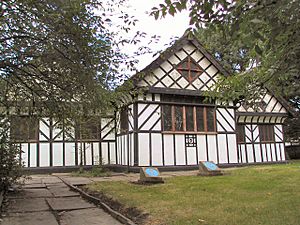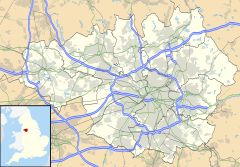St Lawrence's Church, Denton facts for kids
Quick facts for kids St Lawrence's Church, Denton |
|
|---|---|

St Lawrence's Church in 2005
|
|
| Religion | |
| Affiliation | Church of England |
| District | Diocese of Manchester |
| Province | Province of York |
| Ecclesiastical or organizational status | Parish church |
| Location | |
| Location | Denton, Greater Manchester, England |
| Architecture | |
| Architect(s) | J Medland Taylor and Henry Taylor |
| Architectural type | Church |
| Completed | 1532 |
| Materials | Timber framed |
| St Lawrence's Church, Denton | |
|---|---|

St Lawrence's Church in 2005
|
|
| Religion | |
| Affiliation | Church of England |
| District | Diocese of Manchester |
| Province | Province of York |
| Ecclesiastical or organizational status | Parish church |
| Location | |
| Location | Denton, Greater Manchester, England |
| Architecture | |
| Architect(s) | J Medland Taylor and Henry Taylor |
| Architectural type | Church |
| Completed | 1532 |
| Materials | Timber framed |
St Lawrence's Church in Denton is a very old and special church. It's mostly made of wood, which is quite rare! It is one of only 29 churches and chapels in England that are still standing and built with a timber frame. This means it's a "Grade II* listed building", which is like saying it's a really important historical building that needs to be protected.
A Look at Its History
The area of Denton got its own small church, called a "chapelry," in 1531. This was when the first building, a "chapel of ease", was built. A chapel of ease is a church built for people who live far from the main parish church. At that time, it was a Roman Catholic church and was dedicated to St James. It was part of the Diocese of Lichfield.
In 1839, the church was rededicated, meaning its name was changed, to St Lawrence. Later, in 1854, it became a full "parish church." This means it became the main church for the local area.
Changes and Updates
The church was made bigger and updated in 1872 by architects J Medland Taylor and Henry Taylor. Inside, you can find beautiful stained glass windows that are from the 1500s.
The church has been carefully looked after over the years. It went through a big restoration project between 1993 and 2003. This work was paid for by Tameside Metropolitan Borough Council. More restoration work started in 2009 to keep this historic building in good condition.


